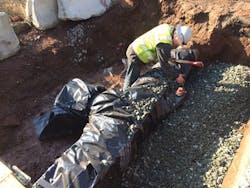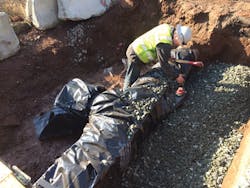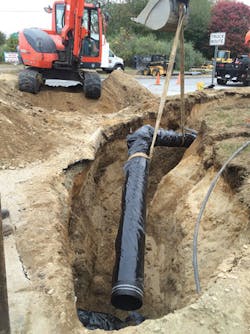Protect Your Investment: 7 Benefits of Polyethylene Encasement
By Keith Waterhouse
When tasked with installing new ductile iron water main, a top priority should not be how fast it can go into service but how you will protect it from corrosion. Cathodic protection, polyethylene encasement, and manufacturer-applied bonded coatings are all widely available through manufacturers and suppliers. Nevertheless, trying to decide on what type of corrosion control is right for your investment can be difficult. Several methods are offered in the marketplace with vast differences in price and protection thresholds.
It’s a common misconception that the standard 1-mil asphaltic coating applied to ductile iron pipe during manufacturing provides adequate corrosion protection. In fact, the coating is applied in accordance with ANSI/AWWA C151/A21.51 to reduce atmospheric oxidation, which merely prolongs the exterior beauty of new pipe before any subsurface installation. Some manufacturers offer a sacrificial metallic-zinc layer beneath the standard asphaltic coating to act as corrosion control. However, any damage to the coating during transit or handling may go unnoticed, creating an increased risk for spot corrosion.
The process of applying a bonded coating can also prove counterintuitive to the corrosion protection that’s expected. In order for the coating to properly adhere, sand- and shot-blasting are used in pipe preparation. This aggressive technique is crucial for bonding but it also comes with the risk of “blistering” or “slivering” the annealed oxide layer of the new pipe. Furthermore, this method does little to protect valves, fittings, and other appurtenances of the pipeline.
And anode systems (i.e., cathodic protection systems), while highly effective, are very expensive and require ongoing maintenance and costs.
One corrosion control method stands out as economical and proven: polyethylene encasement. Since it was first installed in 1958, polyethylene encasement (or polywrap) has been a proven defense against ductile iron corrosion. The Ductile Iron Pipe Research Association (DIPRA) - the authority on the manufacture, installation, handling, testing, and the overall protection of ductile iron - originated tests on the effectiveness of polywrap at many of its test sites across the United States. DIPRA concluded that even under the most extreme conditions, the life expectancy of encased ductile iron can easily exceed a century or more.
In addition to DIPRA’s tests, similar results have been achieved amongst the millions of feet of encased ductile iron that have been installed over the last fifty years. Polyethylene encasement provides a cost-saving, resilient, and passive approach to ductile iron corrosion protection. The following list outlines seven reasons why you should consider polywrap on your next ductile iron pipeline:
1. The most obvious reason to use polywrap is its robust resistance against the contributing factors that equate to corrosive soils. The most common are: low and high pH levels, excessive organic material, sulfides, industrial waste, excessive groundwater, and stray current. Whether individually or in conjunction, these factors all have the tendency to accelerate corrosion on ductile iron. Also, polyethylene is highly resistant to many chemicals and compounds that, if contacted, could instantly harm the exterior of the pipe.
2. The dielectric properties of polyethylene protect against low-level stray current. While the rubber gasket design of ductile iron pipe makes it electrically discontinuous, certain environments can increase the risk of stray current becoming attracted to the pipe. These areas can include electric railways, electrical generation facilities, industrial areas, and proximity to cathodic protection anode beds.
3. The affordability of polywrap makes for an attractive return on investment, costing roughly a fifth of the price of a bonded coating. Additionally, it’s not uncommon for a sacrificial-anode system to equate to 30 times the initial cost of polywrap. Compounded with the costs of maintenance, transportation, and packaging, the additional expenses skyrocket.
4. Unlike elaborate cathodic protection systems, polywrap requires zero maintenance, no continuous monitoring, and no additional operating expenses. With proper installation and care when backfilling, the corrosion protection afforded by polyethylene encasement can be trusted for the life of the pipe.
5. Most suppliers of polywrap sell the product in many different sizes and colors to accommodate your particular project. Color-specific polywrap has the added benefit of allowing the encapsulated pipe to be easily identified should it become exposed during an excavation. Commonly stocked roll lengths are 150’ and 300’ but your supplier may offer a larger variety since most manufacturers accept special orders. Another option to consider when ordering your polywrap is a continuous roll, or one that is perforated along common pipe length intervals. This alternative not only saves time during installation but helps reduce waste.
6. Polywrap is very easy to install and repair. A quick tutorial is all that’s required to make a proficient installer out of anyone on the pipeline crew. Other than a few hand tools, not much else is required for installation equipment. ANSI/AWWA C105/A21.5 provides a descriptive guide that details multiple methods of installation depending on field conditions. Furthermore, any damage caused to the polywrap during installation or handling is easily repaired. Should the encasement become ripped, torn, or even cut, patching with 3-inch-wide PVC tape is all that’s required. Larger tears can be overlaid with an appropriate sized sheet of polywrap and taped along the edges.
7. Installed polywrap will not deteriorate or degrade over time. Polyethylene, by virtue of its chemical composition, can last for centuries, quelling any skepticism of its longevity. Tests performed by DIPRA on an installed portion of 6-inch ductile iron encapsulated in 8-mil polyethylene concluded that, even after 36 years, both the pipe and the encasement were in excellent condition. This is just one example of many that provide insight into the successful history of polywrap.
As outlined above, the benefits of applying polyethylene encasement to your new infrastructure project are clear and the cost savings and installation method, compared to other corrosion protection systems, are significantly less. Further, polywrap provides unparalleled resistance to a long list of harmful foreign materials and chemicals lurking within the soil, and extensive purchase options allow for tailoring to fit the needs of any project. Although there are other practices of corrosion protection for ductile iron pipe, polyethylene encasement continues to be the most economical and widely used method of protection across the United States.
Author’s Note: Detailed information on the proper installation and handling of polyethylene encased pipe can be found at www.dipra.org.
About the Author: Keith Waterhouse has worked for Connecticut Water Company for 15 years. He currently serves as an engineering project coordinator and is certified as a Class 3 Distribution Operator, Cross Connections Survey Inspector, and Backflow Device Tester.


